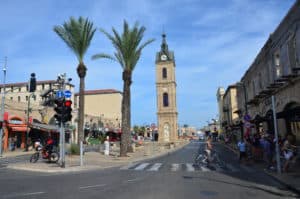Last updated on .
Clock Tower Square is one of the main areas of Jaffa. During the late Ottoman period, it was the center of Ottoman government.

Jaffa Clock Tower
In the center of Clock Tower Square is the Jaffa Clock Tower, which is one of the symbols of Jaffa. It was built between 1900 and 1903 to commemorate the 25th year of the reign of Ottoman Sultan Abdülhamid II.
The clocks were designed by local Jewish businessman and clockmaker Moritz Schoenberg. It was renovated in 1966.
Saraya House
On the east side of Clock Tower Square are the remains of the Saraya House. It was built in 1897 as part of a new Ottoman government complex. The building served as the home of the Ottoman governor as well as a government building. It was designed by engineer Baruch Pepermeister.
The Saraya House was blown up on January 4, 1948, by members of the Lehi. Only the governors residence and a small part of the government building survived. The residence was renovated and the pillars of the government building were restored. The Old Saraya House is around the corner at the bottom of the HaPisgah Gardens.
Ottoman Prison
Opposite the Saraya House is The Setai Tel Aviv. This luxury hotel is made up of five buildings and once served as an Ottoman prison and police station.
Al-Mahmoudiya Mosque
Just around the corner, on our way to the HaPisgah Gardens and Old Jaffa, we passed the al-Mahmoudiya Mosque. The mosque was commissioned in 1730 by Ottoman governor Sheikh Muhammad al-Khalili. It was completed in 1812 by Ottoman governor Muhammad Abu Nabbut, during the reign of Sultan Mahmud II. Columns from ancient Caesarea and Ashkelon were used in its construction and it’s the largest mosque in Jaffa.
A fountain on the southern exterior wall of the mosque is attributed to Sulayman Pasha al-Adil (1760s-1819), the Ottoman governor of Acre in the early 19th century. The mosque is closed to non-Muslims.
Jaffa Flea Market
To get to Clock Tower Square from our hotel, we walked through the flea market area. The Jaffa Flea Market, or Shuk HaPishpishim, is spread out over a series of streets and alleys running south from Clock Tower Square.
The flea market has been running since about the early 20th century. It operates during daylight hours from Sunday to Friday, and attracts both locals and tourists.
Many stalls and shops in the flea market sell junk, but there’s plenty of antiques, traditional Arabic pottery and ceramics, Hollywood memorabilia, carpets, musical instruments, art, and much more to be found. The many trendy restaurants, bars, and cafés make it a great place to hang out at any time of day.